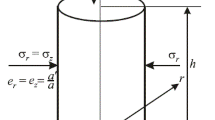Abstract
The physical fields in porous materials under strong shock wave reaction are very complicated. We simulate such systems using the grain contact material point method. The complex temperature fields in the material are treated with the morphological characterization. To compare the structures and evolution of characteristic regimes under various temperature thresholds, we introduce two concepts, structure similarity and process similarity. It is found that the temperature pattern dynamics may show high similarity under various conditions. Within the same material, the structures and evolution of high-temperature regimes may show high similarity if the shock strength and temperature threshold are chosen appropriately. For process similarity in materials with high porosity, the required temperature threshold increases parabolically with the impact velocity. When the porosity becomes lower, the increasing rate becomes higher. For process similarity in different materials, the required temperature threshold and the porosity follow a power-law relationship in some range.
Similar content being viewed by others
References
Nesterenko V F. Dynamics of Heterogeneous Materials. New York: Springer-Verlag, 2001
Hong J, Xu A G. Effects of gravity and nonlinearity on the waves in the granular chain. Phys Rev E, 2001, 63: 061310-1–061310-7
Hong J, Xu A G. Nondestructive identification of impurities in granular medium. Appl Phys Lett, 2002, 81: 4868–4870
Xu A G, Pan X F, Zhang G C, et al. Material-points imulation of cavity collapse under shock. J Phys-Condens Matter, 2007, 19: 326212
Pan X F, Xu A G, Zhang G C, et al. Generalized interpolation material point approach to high melting explosive with cavities under shock. J Phys D-Appl Phys, 2008, 41: 015401
Butcher B M, Carroll M M, Holt A C. Shock-wave compaction of porous aluminum. J Appl Phys, 1974, 45: 3864–3875
Wu Q, Jing F Q. Unified thermodynamic equation-of-state for porous materials in a wide pressure range. Appl Phys Lett, 1995, 67: 49–51
Xu A G, Pan X F, Zhang G C, et al. Morphological characterization of shocked porous material. J Phys D-Appl Phys, 2009, 42: 075409
Yang Q L, Zhang G C, Xu A G, et al. Molecular dynamics simulations of shock induced colapse in single crystal copper with na nano-void inclusion. Acta Phys Sin, 2008, 57: 940–946
Fang B Q, Lu G, Zhang G C, et al. Evolution of stacking-fault-tetrahedron-like structures in copper crystal. Acta Phys Sin, 2009, 58: 4862–4871
Pan X F, Xu A G, Zhang G C, et al. Three-dimensional multi-mesh material point Method for solving collision problems. Commun Theor Phys, 2008, 49: 1129–1138
Ma S, Zhang X, Qiu X M. Comparison study of MPM and SPH in modeling hypervelocity impact problems. Int J Impact Eng, 2009, 36: 272–282
Xu X S, Zhang W X. Introduction to Practical Equation of State. Beijing: Science Press, 1986. 418–446
Sun J S, Zhu J S. Theoretical Explosion Physics. Beijing: National Defence Industry Press, 1995. 88–134
Zhang G R, Chen D N. Initiation Dynamics of Condensed Explosives. Beijing: National Defence Industry Press, 1991. 35–37
Zhang B P, Zhang Q M, Huang F L. Explosion Physics. Beijing: Ordnance Industry Press, 2001. 375–391
Author information
Authors and Affiliations
Corresponding author
Rights and permissions
About this article
Cite this article
Xu, A., Zhang, G., Li, H. et al. Temperature pattern dynamics in shocked porous materials. Sci. China Phys. Mech. Astron. 53, 1466–1474 (2010). https://doi.org/10.1007/s11433-010-4063-5
Received:
Accepted:
Published:
Issue Date:
DOI: https://doi.org/10.1007/s11433-010-4063-5




